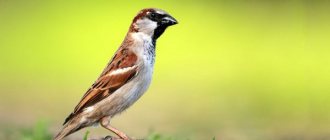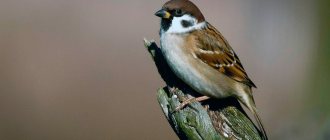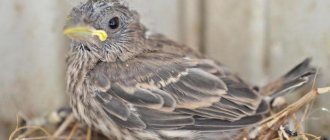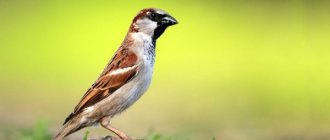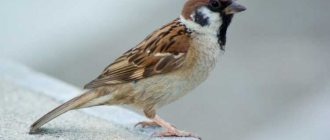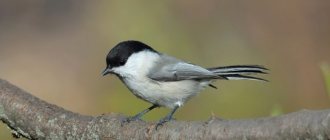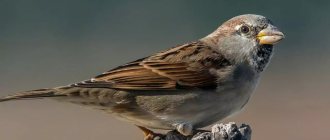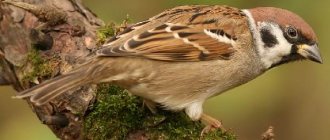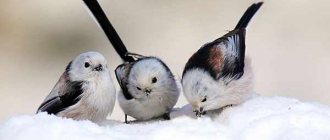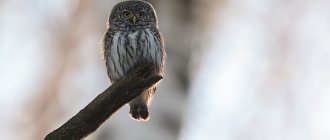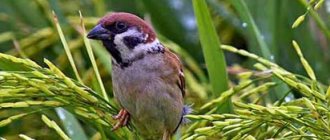Sparrow: about birds for children. Riddles, poems, folk games, chants, educational tales, cartoons about the life of sparrows. Developmental tasks for children. Discover interesting things about the sparrow you have known for a long time together with your children! Have a nice journey into the world of nature and creativity!
Everyone knows the sparrow. And, it would seem, what could be interesting about such a familiar bird? In fact, it is not for nothing that this bird is found in many fairy tales and is loved by Russian folklore. Let's try to find out its secrets! Here, on the new page of the “Encyclopedia of Wintering Birds for Kids” dedicated to the sparrow, you will find many games and tasks for children and you will be able to choose from them what suits your baby.
Appearance and description
The sparrow is a small bird whose colors include grey, brown and black. The belly and head are light in color. Moreover, the color in these places varies from gray to brown, and small black areas may be present. The wings and tail are always dark in color. Depending on the species, the back of the bird's head is painted a certain color, and there may be white stripes on the wings.
Appearance of a sparrow
Appearance of a sparrow
Appearance of a sparrow
Appearance of a sparrow
Appearance of a sparrow
The body of the sparrow is oval in shape, the neck is short and thick, which makes it seem as if it is almost completely absent. The bird presses its wings tightly to its sides and moves them slightly back.
The beak is black in most cases, the tail is short. The eyes are small and bead-shaped. Inside there is a black pupil, and around it there is a gray-brown border. The bird's paws are small, with small claws on the toes.
Nutrition
The smaller the bird, the faster its metabolism. The sparrow is in constant motion and searching for food. He dies within two days without food. The main thing that helps a bird out is its omnivorous nature.
What do sparrows eat? Their diet is varied:
- protein food: small insects, caterpillars;
- cereals, grass seeds;
- grass, vegetables, berries, fruits.
- pieces of meat, lard;
- food waste;
- bread crumbs.
Despite the fact that the sparrow cannot be called a “gourmet,” such indiscriminate eating ensures the population’s survival in the wild.
Dimensions
Adults usually grow up to 14 cm, but some, especially large ones, stretch up to 18 cm. The weight of the bird is approximately 35 grams, and the wingspan is 27-30 cm. Males usually grow larger than females, which makes it possible to distinguish them from each other. Such small sizes help sparrows remain invisible in the foliage of trees and hide from predators.
Interesting fact : sparrows, like magpies, tend to grab small shiny objects and take them to their nests.
Outdoor games for kids about sparrows and other birds.
Pigeons, sparrows and a crow.
Children are pigeons and sparrows. The leader is a crow. Children depict the habits of their birds - how they walk, how they peck grains. Pigeons walk slowly and importantly, sparrows jump quickly.
The crow flies out! The birds must run beyond the outlined line from the crow. Those who didn’t make it in time, and whoever was hit by the crow, become the leader in the next game.
Sparrows and a car.
Game for children 3-4 years old. The sparrows jump and peck the grains. When a car appears (a child holding the steering wheel in his hands, who blows: “Beep-beep-beep”), the sparrows scatter in all directions from the car
Sparrows and crows.
A very fun game for children, which is often played at folk festivals or on family trips. Draw two lines on the ground or floor. The lines should be located three steps apart and should be parallel. Stepping back from these lines another 20-30 steps, draw two more parallel lines.
All players are divided into two teams. One team of crows, the other team of sparrows. They stand with their backs to each other on two lines in the middle of the playing field.
The presenter loudly pronounces the command: “Voro - pause - beat!” or “Voro - pause - us!” The team named by the leader runs to the far line. Players from the other team try to catch up with them and tarnish them.
The winning team is the one that has damaged more players from the second team during the game. The game is repeated six to eight times.
Differences between a male and a female
Male and female sparrow
You can distinguish a male from a female not only by size, but also by color. Males have a black spot under the beak, shaped like a tie, and the head is brown in color, and sometimes there may be areas of a reddish tint on the cheeks. Females have a gray nape and beak. Females also have light brown feathers on their wings, which are absent in males.
What does it eat?
Sparrows often feed on nuts and grains.
Sparrows can be found almost everywhere: in cities, villages, fields and forests. Wherever a person goes, everywhere he can see flocks of these wonderful birds. The majority of sparrows live side by side with humans. They build nests near houses, and people constantly feed them.
Interesting: Why do pigeons walk and sparrows jump? Description, photo and video
The sparrow is a bird that is not picky about food and does not refuse the grain mixture; it picks up all the seeds and crumbs that have fallen to the ground. Sparrows also eat seeds on branches and eat weeds left over from the fall. They love to eat viburnum and rowan berries. Understanding people, when picking berries in the fall, leave some on the tree to feed the birds.
Little-known facts about sparrows that will surprise you
Many of us wake up in the morning due to the chirping of sparrows. The close proximity to our homes has made them an integral part of our environment. But how much do we know about our winged neighbors?
- Sparrows are small birds in the family Passeridae, although some species of sparrows are included in the scientific family Emberizidae.
- Scientists estimate that there are a total of 140 species of sparrows worldwide. Their total number reaches almost a billion individuals.
- This is a synanthropic bird species. Sparrows are adapted to life among people and are their constant companions.
- Sparrows are tiny birds. They can reach between 14 and 16 cm in length and weigh between 22 and 40 grams.
- Despite the small size of the body, sparrows have large paws and a wingspan of up to 27 cm.
- Sparrows usually fly at a speed of 38.5 km/h. If necessary (in case of danger), they can accelerate to a speed of 50 km/h.
- Males and females can be easily distinguished by coloration: males have rust-colored back feathers, a black bib and a dark gray crown, while females have brown and striped back feathers, a gray-yellow eye stripe and a gray head.
- Unlike other birds, sparrows are practically impossible to find in forests or deserts. They prefer to be in close proximity to populated areas.
- Although sparrows do not belong to the group of waterfowl, they can swim very quickly to escape predators.
- Sparrows love to take a dust bath by ruffling their feathers and brushing dirt away.
Photo: www.forbes.com
- Sparrows are omnivores, although they primarily eat grains and seeds, as well as livestock feed and, in cities, discarded food. They love to eat corn, oats, wheat, berries and flower buds. Among wild crops they prefer ragweed, crabgrass and buckwheat. Sparrows readily eat bird food, including millet and sunflowers. In summer they eat insects and feed them to their young.
- Sparrows nest in niches of buildings, on roofs, signs and overhanging lamps. They sometimes build nests on vines and in tree hollows.
- Sparrows often reuse their nests.
- When males present themselves to a potential mate, they ruffle their chest feathers, partially open their wings, fan out their tail, and bounce vigorously in front of the female, turning sideways and sometimes bowing.
- Sparrow nests are made from coarse dried vegetation, which is used to compact the bottom. Finer materials are then used, including feathers, rope and paper. Sparrows sometimes build nests next to each other, so neighboring nests sometimes share walls.
- Females lay three to five eggs. The incubation period for sparrows lasts from 12 to 15 days. It is noteworthy that both parents take care of the eggs and chicks.
- The eggs range in color from light white to greenish-white or bluish-white, usually with gray or brown spots.
Photo: www.terminix.com
- When hatching, the chick is completely naked, with bright pink skin, with its eyes closed. The young are ready to leave the nest 15 days after birth.
- Most pairs have at least two to three litters per year.
- Sparrows jump rather than walk on the ground.
- Sparrows are sedentary birds. They do not migrate, but urban flocks traditionally migrate into the countryside in late summer to feed in ripening grain fields.
- They quickly learn new feeding habits and soon adapt to feeding from hanging feeders.
- They have been observed to catch moths attracted to the light.
- Sparrows can live four to five years in the wild. The oldest sparrow recorded to date is known to have lived for 15 years and 9 months!
- They were once one of the most common birds in Europe, but their numbers have declined sharply in recent years. In some urban areas, populations have declined by 99%. The reason for the sudden extinction remains a mystery, although many theories have been put forward: increasing pollution, shrinking green spaces in cities, climate change, installation of cell towers, etc.
Habitat - where it lives
Habitat of the House Sparrow
Different species of sparrows live almost all over the world. The exception is areas that are too cold or hot, where food is almost completely absent. The bird’s body copes well with any weather conditions, so its absence in a certain area in most cases is associated only with heavy food production.
Sparrows willingly settle near humans: people often leave food in special feeders, which greatly simplifies the process of finding food. The bird is also found in forests, fields, tundra and other areas.
Where does the word "sparrow" come from?
The first secret of sparrows is why they are called that? Ask your child to guess where the name of the sparrow came from: “Beat the thief!” Hit the thief!” Oh, that’s how it turns out, “beat the thief.” So the sparrow is our thief! What is he stealing? Probably grains. And what else? Crumbs. Whose sparrow steals grains and crumbs? In pigeons, dogs, cats and even in people (Of course, you have seen with children how nimble sparrows carry crumbs right from under the noses of clumsy, slow pigeons. And at a bird feeder, sparrows will not get confused and will not be left without food! And because... under the dog's nose they can grab the crumbs right from its bowl). It turns out that while others are gaping, the sparrow is right there - stealing the grain. And in this “beat the thief” the character of the bird sounds - nimble, agile, cunning, pugnacious, brave. cocky.
But scientists think differently. They believe that our sparrow is not our thief at all. They say that the word "sparrow" comes from the ancient "thief". From this “thief” the words we know as “fence” or “gate” come from. Why then “throw and beat”? Because a sparrow is a bird that sits on fences and gates and has lived next to a person for a long time.
There is another opinion. That the word “sparrow” is based on the word “vork” - coo, grumble. And sparrows got their name because they are restless and tweet all the time,
sparrow nest
Sparrow's nest
Sparrows settle in residential buildings, building nests under eaves and on common balconies. Birds can also live in tree hollows. Sparrows do not like to spend a lot of time creating a nest, so they often simply pile pieces of grass, straw and leaves in a secluded place. Due to the fact that the structure is fragile, it can be destroyed by winds and heavy rains. In this case, construction begins again. The diameter of the nest is approximately 12 cm, the height is 7 cm. The bottom is lined with feathers, leaves and materials that can provide heat. The outlet of the nest is located on the side.
Interesting fact : sparrows are able to occupy other people's nests, evicting the previous inhabitants.
Character and lifestyle
Sparrows prefer to stay in one territory for a long time and rarely fly to other places. If there is enough food on the lands chosen for habitat, the birds immediately build nests and settle in them.
Sparrows gather in flocks, and the offspring do not leave their parents. If there is enough food in the area, the birds become quite prolific, causing their numbers to grow rapidly. Sparrows form pairs for life.
When interacting with other males that are part of the pack, males are capable of showing aggression. Then they begin to chirp loudly, spread their wings in different directions and jostle with their opponent.
Habitat and lifestyle
These birds live on almost all continents, with the exception of Antarctica and the Arctic. Although sparrows lead a sedentary lifestyle and do not fly to warmer regions, they migrate in search of new places for food. They often follow in the footsteps of humans to new cities, settlements, and newly plowed lands. The migration routes of sparrows in Russia reached Karelia, the Murmansk region and even certain regions of Yakutia.
In terms of behavior, this bird is noisy, constantly moving, and its chirping can be heard. Sparrows have a somewhat quarrelsome character and often engage in small fights for food during the mating period. At the same time, the sparrow, which was the first to find food, gives a signal to the others. In case of danger, the flock has a guard.
Birds clean their plumage of pests by “bathing” in the sand. They don't look very clean after this, but this method is quite effective.
Sparrows are good swimmers and during periods of danger threatening them they can hide from the enemy through the water.
Short legs literally do not allow the bird to “run away”, so they move on a hard surface by jumping.
Ornithologists previously claimed that sparrows form permanent pairs. Recent research by geneticists refutes this claim. In cubs of the same clutch, there are isolated cases when only the genome of their parents is detected.
Reproduction and offspring
Sparrow chick
Sparrows build nests in the cracks of buildings, they especially like to settle under the eaves of houses, also in hollows of trees and in birdhouses. There are 4-10 white eggs with brownish speckles in a clutch; the chicks hatch after 11-13 days. Both parents incubate the eggs in turns, and begin to do this as soon as the female lays the first egg, so the difference in age, and therefore in weight, in the chicks is up to 10 days, and this is a lot for small birds.
Because of this, in large clutches, younger chicks usually do not survive. The cubs are under the care of caring parents until they learn to fly well. Until then, the chicks are protected from predators and fed with insects. Over the summer, a married couple manages to raise 2–3 broods.
Interesting: Shoebill - description, habitat, nutrition, reproduction, interesting facts, photos and videos
Natural enemies
The owl is one of the natural enemies of the sparrow.
In nature, the sparrow has many natural enemies. The main ones are yard cats, who do not deny themselves the pleasure of feasting on this prey. The sparrow can also be pursued by birds of prey. For example, owls and hawks are able to grab unwary individuals with their paws and carry them to a secluded place. Due to the large difference in size, the sparrow is physically unable to resist.
Kinds
In nature, there are more than 30 species of sparrows that have certain characteristics and a unique appearance. Below are the main ones.
Black-breasted Sparrow
Black-breasted Sparrow
The species has a second name - “Spanish Sparrow”, and is found in Spain, Iraq, Asia, Africa and Pakistan. The bird has a brown color on its head, wings and neck. The back and area near the eyes are covered with light spots. There are a large number of black markings on the abdomen. Males are brighter in color than females. The average size of the bird is 16 cm.
Snow sparrow
Snow sparrow
Adults grow up to 18 cm, weight ranges from 30 to 58 g. Snow sparrows live in the Alps, the Caucasus, Asia and the Balkans. The bird has a white chest and tail. The wings have black and brown feathers. You can see a small tie on the neck.
Red sparrow
Rufous Sparrow
The main distinguishing feature of the species is the presence of bright orange areas on the head, back and wings. The red-haired sparrow is found in Asia, India, and Sakhalin. The wingspan of an adult is approximately 8 cm. Birds often gather in flocks of 15-20 individuals for survival.
Stone sparrow
Stone Sparrow
The beak of stone sparrows is orange, and there is a light stripe on the head. The bird's color is white and brown, with some feathers having gray and black areas. The size of the stone sparrow ranges from 14 to 17 cm, weight does not exceed 40 g.
Mongolian ground sparrow
Mongolian Ground Sparrow
Individuals of this species have an elongated body and a gray color. There are white spots on the body, and orange and black feathers are present on the wings. The main population of the species lives in Mongolia and can also be found on the border with Russia.
Short-fingered sparrow
Short-fingered Sparrow
Most individuals are sandy in color, with feathers that have light edges and dark brown areas. The beak is dark pink, the eyes look like black beads. Individuals grow no more than 15 cm in length, and their weight is 35 g.
Description of the bird
A small bird of brownish-brown plumage with gray, white, and black splashes gave its name to a numerous species of passerines. It includes small birds - finches, goldfinches, singing nightingales, brightly colored orioles, a tiny wren (weighing up to 10 grams), and subspecies that do not look like sparrows - black crows, chirping magpies, jackdaws. The exotic lyrebird is an Australian bird, considered a symbol and national treasure of the country because of the beautiful long tail of the males, also a passerine species. This species includes birds of paradise with unusually beautiful colors, tropical inhabitants of the islands of Indonesia and New Guinea. There are only about 5,000 subspecies of passerines.
Physiological characteristics
The small weight and size of the sparrow determine certain physiological and behavioral characteristics. Due to the short tail and wingspan, the bird can fly for up to a quarter of an hour. The Chinese took advantage of this feature to combat sparrows in 1958, during the time of Mao. They figured that the large bird population was eating a lot of rice and grains. A mass movement against birds began. Using various kinds of noise effects, they were prevented from landing for 15 minutes, and the birds died. The harvest actually grew in the first year, but in the second year it was almost destroyed by locusts and caterpillars that the sparrows fed on, which led to famine and millions of deaths among the Chinese.
Physiological characteristics of sparrows:
- weight - up to 25 grams;
- bird length - 16-18 cm;
- average body temperature - 44 ⁰С;
- pulse reaches 860 beats per minute;
- accelerated metabolism (food is digested and excreted in the form of droppings in an average of 15 minutes);
- plumage has up to 1300 feathers;
- Life expectancy under normal natural conditions is on average up to two years.
The bird's high heart rate (14 times that of a human) gave rise to the saying "trembles like a sparrow."
Why was it called "Sparrow"
It is believed that the name of the bird comes from the ancient Slavic word “gorobets”, which means “pockmarked”. Considering that the sparrow’s color has many areas where there are black and gray spots on a brown background, it could have gotten its name based on just such a feature.
Interesting: Flies: nutrition, vision, smell, danger, benefits, types, photos and videos
There is also an opinion that the bird was so nicknamed because of the sounds it makes. The sparrow communicates with trills similar to “vrk-vrk.” This sound is similar to the ancient word “vork”, which means “to grumble”, “to coo”.
Population and species status
In recent years, ornithologists have noticed that the sparrow population has begun to gradually decline. Previously, huge flocks of birds flew, but now you can only see a few dozen individuals, and even then not in every yard. What is this connected with?
Sparrows are disappearing due to poor quality food filled with chemicals. Sprayed chemical fertilizers are increasingly being used on fields. Birds that eat grain from farm lands stop producing calcium in their bodies, which is necessary for the construction of eggshells. Also, soil and water pollution, intensive urban development, and an increase in mobile phone towers contribute to the reduction in the number of sparrows. This negatively affects the health and genetics of the birds.
Ornithologists say that in order to save sparrows, people must feed them with quality products and build birdhouses and feeders. Also, a person should monitor the purity of nature: do not throw away garbage wherever you want, also do not burn it yourself, since burning plastic is dangerous for the environment and living organisms, if possible, do not use pesticides, and treat nature with care. Scientists also claim that sparrows can be used as a biological device that can be used to determine the cleanliness of the environment.
The largest bird in this order is the raven, weighing about 1.5 kilograms, the smallest is the wren, weighing only about 10 grams. 2. The sparrow is the most famous bird that lives near human habitation. They have lived next to humans for about 10,000 years.
3. Scientists have established that the homeland of sparrows is Southeast Asia.
4.Sparrows settled all over the earth. They can be found even in settlements of Central Asia and the Far North. But in Central Asia, the sparrow usually keeps a respectful distance from humans.
5.About 1 billion individuals live around the globe. That's about 1 sparrow for every 8 people
6. The weight of an adult sparrow is only 25-35 grams, sometimes a little more.
7. It turns out that sparrows, being in the air, cannot fly for more than 15 minutes; they definitely need rest to recuperate.
8. The sparrow is a monogamous person - birds in a pair are faithful to each other for years.
9. If a sparrow has not had a family since the fall or the female died during the winter, in this case the male is doomed to spend the next season as a bachelor.
10.And then he will look for any opportunity to find a lonely female and persuade her to live together. But this is not easy, because for every hundred sparrows there are 150 sparrows.
Male and female house sparrow
11. The male sparrow differs from the female by a large black spot that covers the crop, throat, chin and upper chest. Another difference is the dark gray top of the head.
12. A sparrow has twice as many vertebrae in its neck as a giraffe.
13. A sparrow’s eyes are built in such a way that it sees the world in a pinkish light.
Snow sparrow
14. The snow sparrow builds its nests in the mountains at an altitude of up to 5000 meters above sea level.
15. The average lifespan of a sparrow is about four years, although there are cases when these birds lived for more than ten years.
16. These birds are very prolific; during the summer there are two broods in the northern regions, and three in the southern regions. The eggs are laid for the second time in June - to be precise, in the second half. The chicks hatch in July.
17. A sparrow lays 4-10 eggs, but most often 5-7 eggs are white, slightly browned, with red spots and specks; incubation takes 11-13 days.
18. Chicks, 10 days after birth, fly out of one nest for the first time.
19. “Yellowthroats” is the name given to young sparrows with yellow coloring around their beaks.
20. Sparrows feed their chicks with meat, butterflies, and caterpillars.
21. When feeding their brood, parents feed about 1000 different insects.
22. At rest, this bird’s heart beats 600-850 times per minute, but already in flight it reaches 1000 times per minute.
23. Therefore, severe fright can be fatal, this can happen because blood pressure increases.
House sparrow, also known as the city sparrow (left) and tree sparrow, also known as the country sparrow (right)
24. In Russia you can find only two of their species: namely, the house sparrow, also known as the city sparrow, and the tree sparrow, popularly known as the village sparrow.
25. Sparrows can be found in rural and urban areas.
26. Sparrows are flocking birds and leave the flock in the warm season for the breeding season.
27. In winter, in order not to freeze at night, they cuddle together.
28. The body temperature of a sparrow is 44 degrees.
29. Most of these birds die without surviving the first winter.
30. Sparrows build nests near residential buildings. They build nests in the cracks of buildings, they especially like to settle under the eaves of houses, also in tree hollows or in birdhouses.
31. Sparrows feed mainly on seeds. They love sunflower, hemp, and wheat grains.
32. Because of their short legs, sparrows are forced to move on the ground by jumping.
33. People have a superstition about a sparrow. It says: a sparrow bathing in the sand is a sign of rain, but in fact, the sparrow with such a convoy gets rid of the parasites that have bothered it, and, of course, cleans its feathers.
34. In winter, sparrows often bathe in the snow.
35. Until 1860, there was not a single sparrow in America; later they were brought from England to destroy caterpillars.
36. The first monument to the sparrow for its fight against insect pests was erected in the USA, in Boston, in the 19th century. This happened shortly after sparrows were introduced to the United States to control caterpillars.
37. The most widespread version of the origin of the word “sparrow” is “beat the thief!” - after all, the bird is prone to stealing and is quite cunning.
38.But in Slavic languages this word has the same root as the word “coo”. The basis of this verb, however, as well as the verb “to grumble,” could have been the hitherto unpreserved word “vork.” This bird was so nicknamed for its constant and incessant chirping.
Chestnut sparrow
39. The chestnut sparrow is a real aggressor. He does not build his own nests, preferring to drive out other birds and occupy their home.
40. The house sparrow is an irreplaceable assistant on the farm. Feeding on all kinds of insects (beetles, grasshoppers, caterpillars, midges) in the summer, birds eat pests of gardens and fields. So, this bird provides an invaluable service to gardeners and farmers.
41. Many rural residents and summer residents who have fruit trees in their yards and gardens, thanks to sparrows, refuse pesticides.
42. A sparrow will not be able to fast for a little more than two days, since it spends a lot of energy per day.
43. It turns out that sparrows are now dying out due to low-quality food filled with chemicals. Sprayed chemical fertilizers began to be used on the fields. Birds that feed on grain from the fields stop producing calcium in their bodies, which is necessary for the construction of eggshells.
44. These birds managed to visit one of the most important books in the world - the Bible.
45. Did you know that a blanket was even woven from the feathers of these birds? In 1992, while preparing for his birthday, the son of one ruler decided to give his father an unusual gift - a large blanket of sewn sparrow feathers.
46. In harsh climatic conditions, sparrows can survive due to the presence of the coccygeal gland. This organ secretes a fatty substance, which is then transferred to the feathers with the help of the beak and protects the body from the cold.
47. In 1958, a company opened in China due to a pest problem. Sparrows were declared the main enemies, since according to the calculations of the helmsman Mao Zedong, they ate about 20-35 thousand tons of rice grown in the rice fields per year.
48. Almost 2 billion, according to statistics, were destroyed by sparrows. After these actions, the harvest was better, but it was heavily eaten by locusts and caterpillars, whose numbers were regulated by sparrows. The result was a period of famine that killed approximately 20 million people. We had to re-import these birds from a neighboring country.
49. Sparrow meat is tasteless and hard, so it is very rarely eaten.
50. Adult caught sparrows tolerate captivity surprisingly poorly. It is likely that these active birds find it difficult to adapt to the limited space of the cage. But artificially fed chicks are tamed well.
photo from the Internet
Keeping at home
Sparrow in a Cage
Sparrows are not considered domestic birds, so only a small percentage of the total population grows in cages. In most cases, if an individual lives in captivity, then the person picked it up as a chick.
Interesting fact : if a chick lies on the ground, covered with feathers and down, it should not be touched. This is how he learns to fly under the watchful supervision of his parents. If the chick is so small that it has not yet begun to grow, it means that it accidentally fell out of the nest and needs help.
House sparrows contain several individuals in spacious cages. Birds quickly get used to care and care. Rock sparrows are best suited for home cultivation. They are the least aggressive and quickly adapt to isolation.
When do they say that? Famous folk expressions about the sparrow.
Ask your child to guess the meaning of these expressions. Explain to your child when we use these expressions and what they mean. Remember the situations in your life that these expressions apply to.
- Ruffled like a sparrow (frozen, shrunk)
- Sparrow knee-deep (about a very shallow stream, puddle, river)
- Shot sparrow - experienced, seasoned
- They make noise like sparrows in the rain (make noise, chatter incessantly)
- The word is not a sparrow; if it flies out, you won’t catch it!
- Time is not a sparrow; if you miss it, you won’t catch it!
Sparrow's voice
Sparrow trills cannot be called melodic. During communication, the bird emits one-time calls, similar to whistling and chirping. House sparrows have a rougher and more sonorous voice. Stone ones make dull sounds, consisting of long trills and short intermittent signals.
The black-breasted sparrow has a loud, high-pitched voice. Representatives of the species communicate in long trills that come in continuous bursts. The snow sparrow echoes its relatives with chirping sounds, which can be either short or stretched over entire long series.

